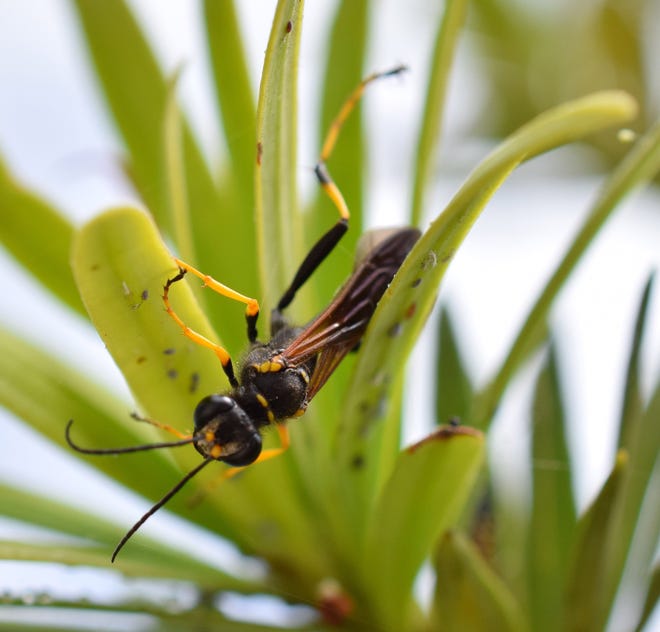Garden Q&A: How to deal with wasps and mud daubers
Becky Wern
When I started my cleanup this spring, I was greeted by a persistent low buzzing sound. Having had a problem last year with her mother or her aunt, I was cautious from the start.
Last year, a wasp chased me onto my porch for the first time ever. Once I was safely inside, she continued to chastise me in wasp language for 20 full minutes. It may have gone on for longer, but I went inside and stopped listening.
Her wrath meant I had gotten too close to her nest in my weeding. She closely resembled a honeybee, but her lower buzz tone and her persistent pursuit of me signaled that she was not a honeybee. Honeybees are pretty laid back, unless you open up their homes when a storm is approaching.
She never landed for me to see her closely, but I found her nest later and two more in my yard. She was a paper wasp. They make their nests by chewing up pieces of dead leaves and wood. They feed their young chewed up pieces of caterpillar.
They aren’t my favorite yard companions, and they make many people nervous. But for the most part I am able to work around them easily until I get next to their nests. When their nests are threatened, they can become aggressive. Who wouldn’t?
Paper wasps like eaves and the undersides of leaves and the undersides of benches for their nests. Their nests can be used year after year, so if you find an abandoned nest it doesn’t hurt to remove it so that the wasps don’t have an easy start the next year.
They can be tolerated until they endanger someone and then you move away or use a quick “knockdown” commercial spray available. Wasps, unlike honeybees, can sting many times and their stings are more painful than bees.
Another member of the wasp family, the mud dauber wasps, will soon be active, and I wish people could be more tolerant of them. These elegant wasps, black and yellow, long and thin are pretty non-threatening — unless you are a fat caterpillar or a brown widow spider.
They do make mud nests on the eaves of your house and carry insects of all kinds to put in them as food for their young. They paralyze the insects by stinging them, then lay an egg on the prey, seal it off in a chamber of mud, and repeat again and again. The larval wasp will use the prey insect or arachnid as a food source as it grows.
In doing so, they help control the insect population while feeding their next generation. A win for us.
After a few weeks, the nest develops holes which means the young have hatched out. Hose it off and all is well.
You would have to catch mud daubers in your bare hands to make them sting you. They just go about their lives living peacefully. There’s no sense in going to war with insects when a little tolerance will do.
Fertilize wisely
Plants that are starting to grow now in your yard will appreciate some fertilizer. But it is best to limit the amount of fertilizer we apply because we want to be sure that we don’t end up with fertilizer being washed out of our yards and down into our waterways. The recommendations of the University of Florida are for frequent light applications. Apply ¼ pound of an acid fertilizer to azaleas and camellias and repeat in the summer and fall.Many woody plants surrounded by lawn will be able to get fertilizer from your lawn if it is fertilized. And unless you want to do a lot of trimming, you don’t want to do a lot of fertilizing of mature plants.
I find it useful to give my annual and perennial flowering plants a good sprinkle of a coated timed-release fertilizer. It lasts about 90 days. This reduces the likelihood I will forget to fertilize them and wonder why they are failing later in the season! And then I do mark my calendar to reapply.
It is a little more expensive, but it is less likely to wash away and needs to be applied less often. The steady supply of nutrients helps my plants to flower better, and that is the goal.
While plant fertilizers are often labelled as “plant food,” that is not at all true. Plants are small wonders in that they make their own food (and ours) from the sunlight. What we apply just gives them nutrients to help them accomplish that task. The nitrogen helps the chlorophyll in the leaves capture the sunlight and is key for leaf growth.
Phosphorus, the middle number in the fertilizer trinity, we usually have in abundance in our soils here. It is important for root growth and winter hardiness.
Potassium works with water movement within the plant and promotes strong roots and stems — essential for healthy plants. Having healthy plants is a matter of many pieces coming together. A wonder, really.
Becky Wern is a Master Gardener

